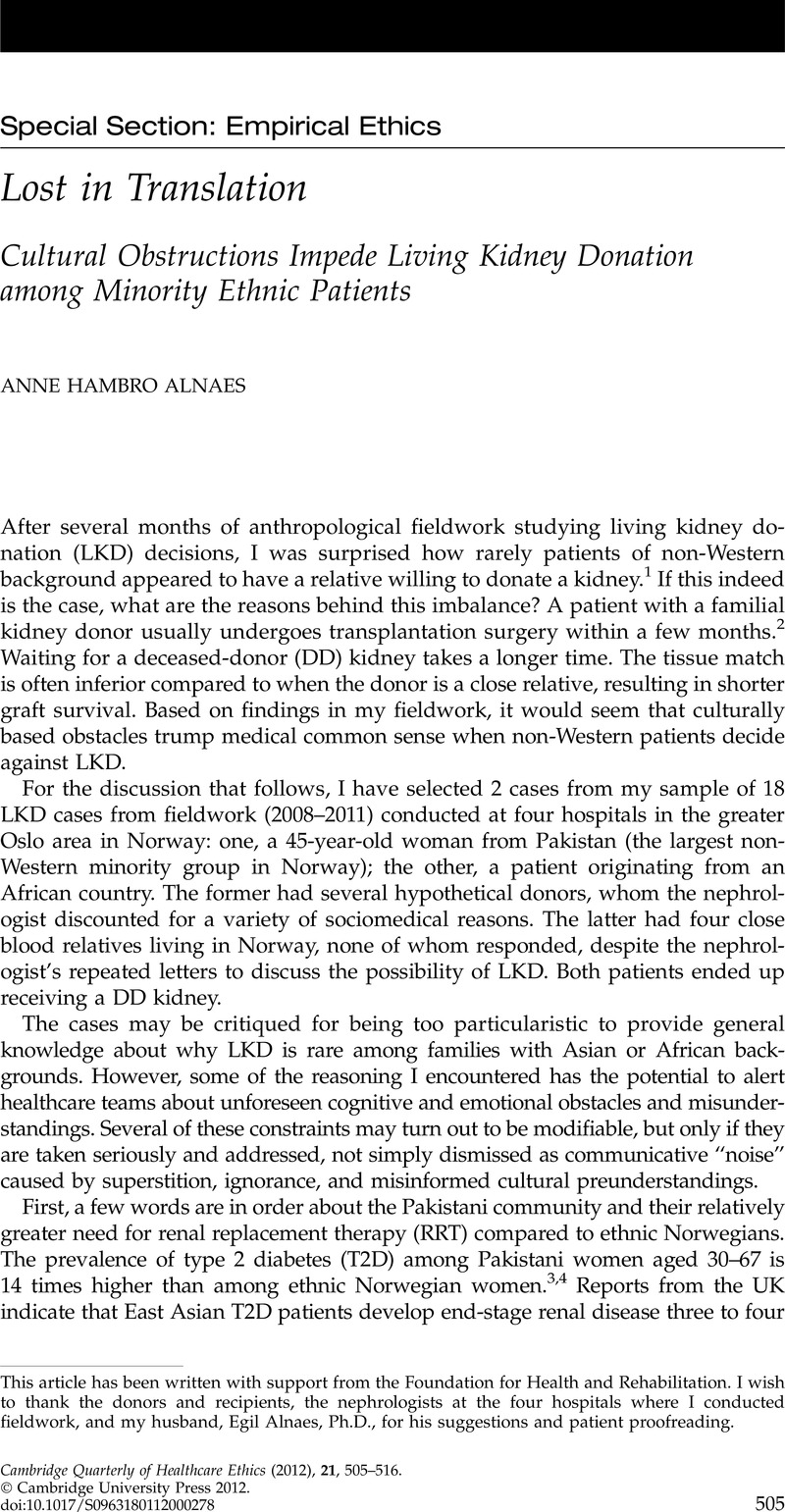Article contents
Lost in Translation
Cultural Obstructions Impede Living Kidney Donation among Minority Ethnic Patients
Published online by Cambridge University Press: 24 July 2012
Abstract

- Type
- Special Section: Empirical Ethics
- Information
- Copyright
- Copyright © Cambridge University Press 2012
References
Notes
1. Living donation rates in Norway (4.8 million) are among the highest in the world (36 per million in 2008). Most patients receive a kidney within one year on the deceased-donor waiting list. See Leivestad T. Annual report. The Norwegian Renal Registry (Norsk Nefrologiregister). Oslo 2009.
2. See note 1, Leivestad 2009.
3. Jenum, AK, Holme, I, Graff-Iversen, S, Birkeland, KI.Ethnicity and sex are strong determinants of diabetes in an urban Western society: Implications for prevention. Diabetologia 2005 Mar;48(3):435–9.CrossRefGoogle Scholar
4. Kumar B, Grøtvedt HE Meyer, Søgaard AJ, Strand BH. The Oslo Health Immigrant Profile. Report from Folkehelseinstituttet 2008:7
5. Randhawa G. Renal health disparities in the United Kingdom: A focus on ethnicity. Seminars in Nephrology 2010;30(1):8–11.
6. Burden, AC, McNally, PG, Feehally, J, Walls, J.Increased incidence of end-stage renal failure secondary to diabetes mellitus in Asian ethnic groups in the United Kingdom. Diabetic Medicine 1992 Aug–Sep;9(7):641–5.CrossRefGoogle ScholarPubMed
7. Randhawa, G. Organ donation and transplantation: The realities for minority ethnic groups in the UK. In: Weimar, W, Bos, B, Buschback, JJ, eds. Organ Transplantation: Ethical, Legal and Psychosocial Aspects Towards a Common European Policy. Lengerich: Pabst; 2008.Google Scholar
8. Blom S. Innvandreres helse 2005/2006. Statistics Norway; 2008.
9. Hymes, Dell. On communicative competence. In: Duranti A, ed. Linguistic Anthropology: A Reader. Oxford: Blackwell 2001.
10. Faden, RR, Beauchamp, TL, King, NMP.A History and Theory of Informed Consent. New York: Oxford University Press; 1986.Google Scholar
11. O’Neill, O.Some limits of informed consent. Journal of Medical Ethics 2003 Feb 1;29(1):4–7, at 4.CrossRefGoogle ScholarPubMed
12. Bourdieu, P, Thompson, JB.Language and Symbolic Power. (trans. Raymond, G, Adamson, M). Cambridge: Polity Press; 1991, at 164.Google Scholar
13. Aid to Capacity Evaluation (ACE); see http://www.utoronto.ca/jcb/disclaimers/ace.htm.
14. Grisso T, Appelbaum PS, Hill-Fotouhi C. The MacCAT-T: A clinical tool to assess patients’ capacities to make treatment decisions. Psychiatric Services 1997 Nov;48(11):1415–9.
15. Emanuel EJ, Emanuel LL. Four models of the physician-patient relationship. JAMA 1992 Apr 22/29;267(16):2221–6.
16. Moazam, F.Bioethics and Organ Transplantation in a Muslim Society. Bloomington and Indianapolis: Indiana University Press; 2006.Google Scholar
17. Alnaes AH. Narratives: An essential tool for evaluating living kidney donations. Medicine Health Care and Philosophy 2012;15(2):181–94.
- 5
- Cited by




